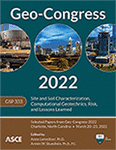Numerical Homogenization of Anisotropic Static Elastic Properties of Soft Mudrocks
Publication: Geo-Congress 2022
ABSTRACT
Soft mudrocks have low permeability and are mostly treated as sealing geological formations. Clay-rich soft mudrocks are also classified as the transversely isotropic (TI) material due to the intrinsic preferred fabric orientation. The TI elastic properties of soft mudrocks are highly dependent on the containing mineralogical compositions and clay fractions. Thus numerical modeling is necessary to estimate the behavior of soft mudrocks. In this study, a two-dimensional homogenization model is employed to assess the elastic moduli of soft mudrocks. Clay-water composites are treated as the hosting matrix, and non-clay minerals are placed in the REV as the inclusions. The inclusions are placed randomly in different sizes. In order to consider the partial flexibility between the non-clay minerals and clay-water composites, an imperfect boundary is defined between the inclusions and matrix using the eXtended Finite Element Method (XFEM). The periodic boundary condition is imposed on the REV, and the homogenized anisotropic elastic moduli of rocks with different clay fractions are estimated. The numerical results were validated using published experimental data on the static TI elastic properties of soft Colorado shale samples. The results show the predictable decreasing trends in elastic modulus of soft mudrocks with increasing of the clay fraction.
Get full access to this article
View all available purchase options and get full access to this chapter.
REFERENCES
Bayuk, I. O., Ammerman, M., and Chesnokov, E. M. (2007). “Elastic moduli of anisotropic clay.” Geophysics, 72(5).
Bosco, E., Kouznetsova, V. G., and Geers, M. G. D. (2015). “Multi‐scale computational homogenization–localization for propagating discontinuities using X‐FEM.” International Journal for Numerical Methods in Engineering, Wiley Online Library, 102(3–4), 496–527.
Chang, C., Zoback, M. D., and Khaksar, A. (2006). “Empirical relations between rock strength and physical properties in sedimentary rocks.” Journal of Petroleum Science and Engineering, Elsevier, 51(3–4), 223–237.
Ebrahimi, D., Pellenq, R. J.-M., and Whittle, A. J. (2012). “Nanoscale elastic properties of montmorillonite upon water adsorption.” Langmuir, ACS Publications, 28(49), 16855–16863.
Erkmen, E., Malek, S., and Ayranci, C. (2020). “An XFEM-based computational homogenization framework for thermal conductivity evaluation of composites with imperfectly bonded inclusions.” Engineering Research Express, IOP Publishing.
Gal, E., Suday, E., and Waisman, H. (2013). “Homogenization of materials having inclusions surrounded by layers modeled by the extended finite element method.” International Journal for Multiscale Computational Engineering, Begel House Inc., 11(3).
Gautam, R., and Wong, R. C. K. (2006). “Transversely isotropic stiffness parameters and their measurement in Colorado shale.” Canadian Geotechnical Journal, 43(12), 1290–1305.
Geers, M. G. D., Kouznetsova, V. G., and Brekelmans, W. A. M. (2010). “Multi-scale computational homogenization: Trends and challenges.” Journal of computational and applied mathematics, Elsevier, 234(7), 2175–2182.
Hassani, B., and Hinton, E. (1998). “A review of homogenization and topology optimization I - Homogenization theory for media with periodic structure.” Computers and Structures, 69(6), 707–717.
Hornby, B. E., Schwartz, L. M., and Hudson, J. A. (1994). “Anisotropic effective-medium modeling of the elastic properties of shales.” Geophysics, 59(10), 1570–1583.
Li, B., and Wong, R. C. K. (2016). “Quantifying structural states of soft mudrocks.” Journal of Geophysical Research: Solid Earth, Wiley Online Library, 121(5), 3324–3347.
Li, B., and Wong, R. C. K. (2017). “Modeling anisotropic static elastic properties of soft mudrocks with different clay fractions.” Geophysics, 82(1), MR27–MR37.
Nguyen, T. N., Erkmen, R. E., Sanchez, L. F. M., and Li, J. (2020). “Stiffness Degradation of Concrete Due to Alkali-Silica Reaction: A Computational Homogenization Approach.” Materials Journal, 117(6), 65–76.
Ortega, J. A., Ulm, F., and Abousleiman, Y. (2010). “The effect of particle shape and grain‐scale properties of shale: A micromechanics approach.” International Journal for Numerical and Analytical Methods in Geomechanics, Wiley Online Library, 34(11), 1124–1156.
Otero, F., Oller, S., and Martinez, X. (2018). “Multiscale computational homogenization: review and proposal of a new enhanced-first-order method.” Archives of Computational Methods in Engineering, Springer, 25(2), 479–505.
Vasin, R. N., Wenk, H., Kanitpanyacharoen, W., Matthies, S., and Wirth, R. (2013). “Elastic anisotropy modeling of Kimmeridge shale.” Journal of geophysical research: solid earth, Wiley Online Library, 118(8), 3931–3956.
Wriggers, P., and Moftah, S. O. (2006). “Mesoscale models for concrete: Homogenisation and damage behaviour.” Finite elements in analysis and design, Elsevier, 42(7), 623–636.
Information & Authors
Information
Published In
History
Published online: Mar 17, 2022
Authors
Metrics & Citations
Metrics
Citations
Download citation
If you have the appropriate software installed, you can download article citation data to the citation manager of your choice. Simply select your manager software from the list below and click Download.
